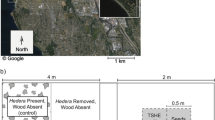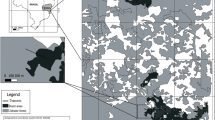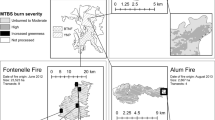Abstract
Seedling recruitment shapes tree communities, including those found in altered landscapes such as urban forests. However, little data exists on local- and broad-scale tree seed immigration and recruitment in these communities. Interspecific competition and seed predation are two major causes of recruitment failure for plants. In North American urban forests, these pressures may be exacerbated by an altered disturbance regime and prevalent invasive species combined with dense populations of rodents and browsers. Preliminary investigation in an urban forest on the eastern shore of Lake Erie indicated very low long-term tree seedling recruitment in the mature canopy stands. Our competing hypotheses were that seed establishment (habitat suitability) and seed limitations (seed availability) explained the tree recruitment failure. We tested seed establishment using field experiments (burning and vertebrate herbivore exclosures) and seed limitation by introducing native tree seeds. Moreover, we tested also seed limitation by examining local and regional seed input using seed traps. We found that seedling recruitment increased significantly with experimental reductions in predators and competitors, suggesting strong biotic establishment limitations in the urban forest. In addition, seed rain correlated significantly with immediately proximate parent plants, but no species arrived beyond what occurs within 50 m of the experimental plots. Essentially, then, the existing canopy species are not replacing themselves and extant seeds are not immigrating to replace them. At the patch scale, habitat quality, particularly seed predation and browsing, as well as competition from nonnative understory shrubs, constrained native tree recruitment in the urban forest. At the landscape scale, the evidence of poor long-term seed recruitment and the lack of long-distance seed input also suggest low native tree seed availability. The tree recruitment failure suggests that, in the absence of active management, this urban forest may eventually convert to an invasive-species dominated urban shrubland.



Similar content being viewed by others
References
Abrams MD, Orwig DA (1996) A 300-year history of disturbance and canopy recruitment for co-occurring white pine and hemlock on Allegheny plateau, USA. J Ecol 84:353–363
Bond WJ, Midgley G (2001) Ecology of sprouting in woody plants: the persistence niche. Trends Ecol Evol 16:45–51
Bonser SP, Aarssen LW (1994) Plastic allometry in young sugar maple (Acer saccharum): adaptive responses to light availability. Am J Bot 81:400–406
Bradley CE, Smith DG (1986) Plains cottonwood recruitment and survival on a prairie meandering river floodplain, milk river, southern Alberta and northern Montana. Can J Bot 64:1433–1442
Cain ML, Milligan BG, Strand AE (2000) Long-distance dispersal in plant populations. Am J Bot 87:1217–1227
Chen L, Wang L, Baiketuerhan Y, Zhang C, Zhao X, von Gadow K (2014) Seed dispersal and seedling recruitment of trees at different successional stages in a temperate forest in northeastern China. J Plant Ecol 7:337–346
Clark JS, Macklin E, Wood L (1998) Stages and spatial scales of recruitment limitation in southern Appalachian forests. Ecol Monogr 68:213–235
Clark CJ, Poulsen JR, Levey DJ, Osenberg CW (2007) Are plant populations seed limited? A critique and meta-analysis of seed addition experiments. Am Nat 170:128–142
Connolly BM, Pearson DE, Mack RN (2014) Granivory of invasive, naturalized, and native plants in communities differentially susceptible to invasion. Ecology 96:1759–1769
Côté M, Ferron J, Gagnon R (2003) Impact of seed and seedling predation by small rodents on early regeneration establishment of black spruce. Can J For Res 33:2362–2371
Crawley, MJ (2000) Seed predators and plant population dynamics. In: Fenner M (ed) Seeds: the Ecology of Regeneration in Plant Communities CAB International, Wallingford, UK, pp 167–182
Crawley MJ, Ross GJS (1990) The population dynamics of plants. Philos Trans R Soc Lond Ser B Biol Sci 330:125–140
Dalling JW, Hubbell SP, Silvera K (1998) Seed dispersal, seedling establishment and gap partitioning among tropical pioneer trees. J Ecol 86:674–689
Dix RL (1960) An application of the point-centered quarter method to sampling of grassland vegetation. J Range Manag 14:63–69
Elliott KJ, Boring LR, Swank WT, Haines BR (1997) Successional changes in plant species diversity and composition after clearcutting a southern Appalachian watershed. For Ecol Manag 92:67–85
Engstrom A (1948) Growing cottonwood from seed. J For 46:130–132
Fagan M, Peart D (2004) Impact of the invasive shrub glossy buckthorn (Rhamnus frangula L.) on juvenile recruitment by canopy trees. For Ecol Manag 194:95–107
Fenner M (1987) Seedlings. New Phytol 106:35–47
Fenner M, Kitajima K (1999) Seed and seedling ecology. In: Pugnaire FI, Valladares F (eds) Handbook of Functional Plant Ecology Marcel. Dekker, New York, pp. 589–611
Fox J, Weisberg S (2011) An R Companion to Applied Regression. Sage, Thousand Oaks
Frappier B, Lee TD, Olson KF, Eckert RT (2003) Small-scale invasion pattern, spread rate, and lag-phase behavior of Rhamnus frangula L. For Ecol Manag 186:1–6
Gill RMA, Morgan G (2010) The effects of varying deer density on natural regeneration in woodlands in lowland Britain. Forestry 83:53–63
Grubb PJ (1977) Maintenance of species-richness in plant communities - importance of regeneration niche. Biol Rev 52:107–145
Grunzweig L, Spiering D, Labatore A, Warren RJ II (2015) Non-native plant invader renders suitable habitat unsuitable. Arthropod Plant Interact 9:577–583
Harper JL (1977) Population Biology of Plants. Academic Press, New York
Heneghan L, Fatemi F, Umek L, Grady K, Fagen K, Workman M (2006) The invasive shrub European buckthorn (Rhamnus cathartica L.) alters soil properties in Midwestern US woodlands. Appl Soil Ecol 32:142–148
Hubbell SP et al. (1999) Light-gap disturbances, recruitment limitation, and tree diversity in a neotropical forest. Science 283:554–557
Huff LM, Potts DL, Hamerlynck EP (2015) Ecosystem CO2 exchange in response to nitrogen and phosphorus addition in a restored, temperate grassland. Am Midl Nat 173:73–87
Hulme PE (1998) Post-dispersal seed predation: consequences for plant demography and evolution. Perspect Plant Ecol Evol Syst 1:32–46
Hulme PE, Benkman CW (2002) Granivory. In: Herrera CM, Pellmyr O (eds) Plant-Animal Interactions. Blackwell, Oxford
Jutila HM, Grace JB (2002) Effects of disturbance on germination and seedling establishment in a coastal prairie grassland: a test of the competitive release hypothesis. J Ecol 90:291–302
Kimmins JP (1987) Forest ecology. Macrnillan Publishing Company, New York
Lobo N (2014) Conifer seed predation by terrestrial small mammals: a review of the patterns, implications, and limitations of top-down and bottom-up interactions. For Ecol Manag 328:45–54
MacDougall AS, Turkington R (2007) Does the type of disturbance matter when restoring disturbance-dependent grasslands. Restor Ecol 15:263–272
Manion PD, Griffin DH (2001) Large landscape scale analysis of tree death in the Adirondack Park. For Sci 47:542–549
McKinney M (2008) Effects of urbanization on species richness: a review of plants and animals. Urban Ecosyst 11:161–176
Michalak J (2011) Effects of habitat and landscape structure on Oregon white oak (Quercus garryana) regeneration across an urban gradient. Northwest Sci 85:182–193
Nathan R, Muller-Landau HC (2000) Spatial patterns of seed dispersal, their determinants, and consequences for recruitment. Trends Ecol Evol 15:278–285
Nuttle T, Royo AA, Adams MB, Carson WP (2013) Historic disturbance regimes promote tree diversity only under low browsing regimes in eastern deciduous forest. Ecol Monogr 83:3–17
Oldfield EE, Warren RJ II, Felson AJ, Bradford MA (2013) Challenges and future directions in urban afforestation. J Appl Ecol 50:1169–1177
Overdyck E, Clarkson BD (2012) Seed rain and soil seed banks limit native regeneration within urban forest restoration plantings in Hamilton City, New Zealand. N Z J Ecol 36:177–190
Pennington DN, Hansel JR, Gorchov DL (2010) Urbanization and riparian forest woody communities: diversity, composition, and structure within a metropolitan landscape. Biol Conserv 143:182–194
Peroni PA (1994) Invasion of red maple (Acer rubrum L.) during old field succession in the North Carolina piedmont: age structure of red maple in young pine stands. Bulletin Torrey Botanical Club 121:357–359
Peters SH, Macdonald SE, Boutin S, Moses RA (2004) Post dispersal seed predation of white spruce in cutblocks in the boreal mixedwoods: a short-term experimental study. Can J For Res 34:907–915
Piqueray J, Saad L, Bizoux J, Mahy G (2013) Why some species cannot colonise restored habitats? The effects of seed and microsite availability. J Nat Conserv 21:189–197
Pulliam HR (2000) On the relationship between niche and distribution. Ecol Lett 3:349–361
R Development Core Team (2015) R: A Language and Environment for Statistical Computing. R Foundation for Statistical Computing, Vienna, Austria
Rooney TP, Solheim SL, Waller DM (2002) Factors influencing the regeneration of northern white cedar in lowland forests of the upper Great Lakes region, USA. For Ecol Manag 163:119–130
Runkle JR (2000) Canopy tree turnover in old-growth Mesic forests of eastern North America. Ecology 81:554–567
Salk TT, Frelich LE, Sugita S, Calcote R, Ferrari JB, Montgomery RA (2011) Poor recruitment is changing the structure and species composition of and old- growth hemlock-hardwood forest. For Ecol Manag 261:1998–2006
Shen WJ, Jianguo W, Grimm NB, Hope D (2008) Effects of urbanization-induced environmental changes on ecosystem functioning in the phoenix metropolitan region, USA. Ecosystems 11:138–155
Shimano K (2000) A power function for forest structure and regeneration pattern of pioneer and climax species in patch mosaic forests. Plant Ecol 146:207–220
Sivy KJ, Ostoja SM, Schupp SM, Durham S (2011) Effects of rodent species, seed species, and predator cues on seed Acta. Oecologia 37:321–328
Spiering D (2009) Tifft Nature Preserve Management Plan. Buffalo Science Museum, Buffalo, NY USA
Sullivan JJ, Meurk C, Whaley KJ, Simcock R (2009) Restoring native ecosystems in urban Auckland: urban soils, isolation, and weeds as impediments to forest establishment. N Z J Ecol 33:60–71
Svenning JC, Wright SJ (2005) Seed limitation in a Panamania forest. J Ecol 93:853–862
Trammell TLE, Carreiro MM (2011) Vegetation composition and structure of woody plant communities along urban interstate corridors in Louisville, KY, USA. Urban Ecosyst 14:501–524
Turnbull LA, Crawley MJ, Rees M (2000) Are plant populations seed-limited? A review of seed sowing experiments. Oikos 88:225–238
Tyler CM, Davis FW, Mahall BE (2008) The relative importance of factors affecting age-specific seedling survival of two co-occurring oak species in southern California. For Ecol Manag 255:3063–3074
USDA, NRCS (2016) The PLANTS Database (http://plants.usda.gov, 2016). National Plant DataTeam, Greensboro, NC
Wang B, Chen J (2009) Seed size, more than nutrient or tannin content, affects seed caching behavior of a common genus of old world rodents. Ecology 90:3023–3032
Wania A, Kühn I, Klotz S (2006) Plant richness patterns in agricultural and urban landscapes in Central Germany – spatial gradients of species richness. Landsc Urban Plan 75:97–110
Warren RJ II, Bradford MA (2011) The shape of things to come: woodland herb niche contraction begins during recruitment in Mesic forest microhabitat. Proc R Soc B-Biol Sci 278:1390–1398
Warren RJ II, Rossell IM, Moorhead KK (2004) Colonization and establishment of red maple (Acer rubrum) in a southern Appalachian wetland. Wetlands 24:364–374
Webster CR, Jenkins MA, Rock JH (2005) Long-term response of spring flora to chronic herbivory and deer exclusion in great Smoky Mountains National Park, USA. Biol Conserv 125:297–307
White MA (2012) Long-term effects of deer browsing: composition, structure, and productivity in a northeastern Minnesota old-growth forest. For Ecol Manag 269:222–228
Acknowledgments
The authors thank Matt Candeias for field assistance and Amy McMillan for manuscript comments. The authors also thank the Tifft Nature Preserve for access to the property and permission to conduct experiments.
Author information
Authors and Affiliations
Corresponding author
Rights and permissions
About this article
Cite this article
Labatore, A.C., Spiering, D.J., Potts, D.L. et al. Canopy trees in an urban landscape – viable forests or long-lived gardens?. Urban Ecosyst 20, 393–401 (2017). https://doi.org/10.1007/s11252-016-0601-x
Published:
Issue Date:
DOI: https://doi.org/10.1007/s11252-016-0601-x




